The Islamic Republic of Iran has a hard task before it. It is a counter-revolutionary regime that has to suppress a revolution… under the guise of being “revolutionary!” After all, how could a regime call itself “revolutionary” and at the same time justify preventing the masses of people from conquering the streets?
Demonstration on September 18, 2009. Photo by .faramarz on flickr.On September 18, the Iranian masses, in a very intelligent move, used Quds Day, typically a day of government-sponsored rallies that nobody goes to, to further their revolution and continue their struggle against the Islamic Republic. This was the biggest presence of the masses on the streets, since the millions-strong demonstrations just after the elections that ignited the revolution. The Quds Day demonstrations proved that the revolution is alive and kicking.
Quds is the Arabic name for Jerusalem and “Quds Day”, the last Friday of Ramadan in the lunar Arabic calendar, is an initiative first launched by Khomeini with the aim of supporting his fellow fundamentalist, anti-leftist colleagues in the region under the disguise of “supporting the Palestinian people”. The Iranian people have always seen through all this and that is why the government has usually had a hard job filling the streets on this day. But not this time around!
In the week building up to this day people were determined to use Quds Day 2009 (September 18) as a stage for their protests. And this is exactly what happened. Depending on the different reports one reads, the demonstrators numbered anything from tens of thousands to one and half million in Tehran. This is despite a very clear warning by the government’s military thugs, the misnamed “Revolutionary Guards”, that declared all protesters would be treated as Israeli spies (the harshest possible accusation in Iran). The protests were not limited to Tehran, however, but took place all over Iran including Tabriz, Qom, Esfahan, Mashhad, Shiraz, Rasht, Booshehr, Ahvaz and Kermanshah.
Contrary to what many of the media have tried to depict, not all the slogans were nationalistic. Although some people did use the slogan of “Not Gaza, Not Lebanon, I give my life to Iran”, this was by no means the dominant slogan. The slogan that evidently became the dominant one was “Death to the Dictator!” According to reports, at one point thousands of protesters filled Valiasr Street, the major avenue in Tehran which runs across much of the city, chanting “Death do the Dictator”. Analysts say that it is pretty clear that they are no longer aiming this slogan only at Ahmadinejad but also at Khamenei, the Great Dictator himself. There were also slogans such as: “Cannons, Tanks, Torture or Rape will not stop us anymore”. This is reminiscent of an old revolutionary slogan of the 1970s used against the Shah’s regime.
What is to be noted is how once again the masses of Iran demonstrated their endless courage and determination in facing up to this criminal regime. On Quds Day, even the trucks of government thugs were surrounded by the protesters. While the government thugs shouted “Death to Israel” from their trucks, the people responded with “Death to Russia”, showing their anger at the Russian government’s cordial relations with the Ahmadinejad government.
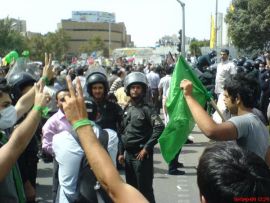 Demonstration on September 18, 2009. Photo by .faramarz on flickr.One interesting detail was the fact that there were also some slogans against Chavez, as unfortunately he has publicly supported the Iranian regime. He has repeatedly come out in support of Ahmadinejad, in the mistaken view that the Iranian regime is “anti-imperialist”. The Venezuelan CMR already warned that this wrong position of Chavez risks alienating those who are the natural supporters of the Venezuelan revolution in Iran, the workers, the youth, the women, who make up the ranks of those who have been struggling against the reactionary Iranian regime in the last few months. [See Solidarity with the movement of the Iranian masses – Statement of the Revolutionary Marxist Current (Venezuela)]
Demonstration on September 18, 2009. Photo by .faramarz on flickr.One interesting detail was the fact that there were also some slogans against Chavez, as unfortunately he has publicly supported the Iranian regime. He has repeatedly come out in support of Ahmadinejad, in the mistaken view that the Iranian regime is “anti-imperialist”. The Venezuelan CMR already warned that this wrong position of Chavez risks alienating those who are the natural supporters of the Venezuelan revolution in Iran, the workers, the youth, the women, who make up the ranks of those who have been struggling against the reactionary Iranian regime in the last few months. [See Solidarity with the movement of the Iranian masses – Statement of the Revolutionary Marxist Current (Venezuela)]
Another interesting aspect was that in the face of the immense courage and determination of the masses on September 18, the police and Basij thugs did not attack the protesters with their usual killings and beatings. Their action was limited to using tear gas and arresting a number of protesters. It was clear that their so-called “leniency” comes out of a fear of openly clashing with hundreds and thousands of people on the streets, and of provoking an even bigger movement
Continuous struggles
The turbulent atmosphere is evident in every part of Iranian society. In the last days of September, the government finally resorted to opening the universities. Ahmadinejad didn’t dare to be present at the opening of the new academic year in Tehran University. He instead sent his Minister of Science, Kamran Daneshjoo, who had to meet hundreds of protesting students who had gathered in front of the Central Library of Tehran University chanting: “Death to the Dictator, both leader and doctor” (referring to “The Supreme Leader, Khamenei” and “Dr. Ahmadinejad”) and also “Students prefer death to indignity”. Students marched through the university and gathered in front of the university entrance in Enqelab Avenue. Only a strong presence of police and security guards prevented students from joining forces with people who had gathered outside the entrance in their support.
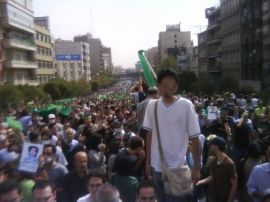 Demonstration on September 18, 2009. Photo by .faramarz on flickr.On October 2, the masses even used the Tehran soccer derby match between two famous Tehran clubs, Persepolis and Esteghlal, to protest against the Ahmadinejad government. The match was in the colossal Azadi Stadium, watched by nearly 100,000 people, and you could even hear the anti-Ahmadinejad slogans on State TV!
Demonstration on September 18, 2009. Photo by .faramarz on flickr.On October 2, the masses even used the Tehran soccer derby match between two famous Tehran clubs, Persepolis and Esteghlal, to protest against the Ahmadinejad government. The match was in the colossal Azadi Stadium, watched by nearly 100,000 people, and you could even hear the anti-Ahmadinejad slogans on State TV!
The Quds Day demonstrations proved a very important point: nothing can take the situation back for the regime to the “good old times” before June 22. People will use every possible opportunity to fill the streets. The “nightmare” of revolution will haunt the Islamic Republic until it comes tumbling down. And it is this fact that colours all further developments.
“Unity of the regime”?
We saw before how the old leaders of the “Reformist” wing of the regime were tried in Tehran show trials by their erstwhile cousins. They were forced to renege on all their ideas. In a humiliating move, Sayid Hajarian ‑ the main “Reformist” ideologue who is the survivor of an assassination attempt and who has always been regarded as sort of a martyr for the reformists ‑ after denouncing whatever he once proclaimed and thanking his “brothers” for his place of confinement (that he described as being more “enjoyable than a prison”) was freed last week.
On the other hand, Mousavi and Karoubi, two election candidates and “leaders of the reformists”, have resorted to unprecedented criticisms of the regime they had once contributed to building. Although they too were careful to add that their ultimate goal is how to “avert the crisis” [read: save the regime] while continuing their criticisms so as not to lose all their support among the masses; support that is already being undermined, the more people progress in their demands. In a statement that would undoubtedly disgust some people who have been putting their lives at risk in fighting this regime, Mousavi said: “Our demand is full execution of the Constitution and the return of the Islamic Republic to its initial ethical principles. We want the Islamic Republic, not a word more, not a word less [echoing Khomeni’s famous saying; my translation, BK] and he then went on to condemn those who want to go “beyond the regime” and break the “structures”.
In general, we could say that the more the revolution has progressed, the more heightened have the internal divisions within the regime become. However, it is Rafsanjani, the fox of the regime, that “Man of crises”, that has astonished his “reformist” allies with an act that reveals that his crude political manoeuvres are truly unpredictable.
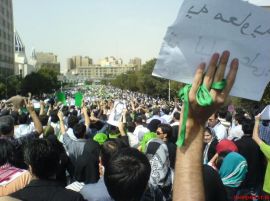 Demonstration on September 18, 2009. Photo by .faramarz on flickr.This astonishing act happened at the 6th Summit of the Assembly of Experts, which is headed by Rafsanjani and has the constitutional power of replacing the Supreme Leader and picking a new one. Many people were contemplating about what this Assembly might do under the leadership of Rafsanjani to counter Khamenei. But the summit, in its final declaration and in its opening speech, gave its full support to Khamenei, as if to pour a bucket of cold water on all the “Reformist” leaders who had tied all their hopes to Rafsanjani. The final declaration praises Ayatollah Khamenei for his role in “putting out the fire of conspiracy and the incidents after the elections”. It goes on to say: “We (members of the Assembly of Experts) once more declare our allegiance to the Supreme Leader of the Revolution, Ayatollah Khamenei…. And we declare him to be the only candidate that is worthy of leading the nation” [my translation, BK].
Demonstration on September 18, 2009. Photo by .faramarz on flickr.This astonishing act happened at the 6th Summit of the Assembly of Experts, which is headed by Rafsanjani and has the constitutional power of replacing the Supreme Leader and picking a new one. Many people were contemplating about what this Assembly might do under the leadership of Rafsanjani to counter Khamenei. But the summit, in its final declaration and in its opening speech, gave its full support to Khamenei, as if to pour a bucket of cold water on all the “Reformist” leaders who had tied all their hopes to Rafsanjani. The final declaration praises Ayatollah Khamenei for his role in “putting out the fire of conspiracy and the incidents after the elections”. It goes on to say: “We (members of the Assembly of Experts) once more declare our allegiance to the Supreme Leader of the Revolution, Ayatollah Khamenei…. And we declare him to be the only candidate that is worthy of leading the nation” [my translation, BK].
The fact that this declaration was read out while Rafsanjani was no longer in the room (he left the summit in the early hours of its second and last day) means simply that he was trying not to completely alienate himself from his “Reformist brothers” and not to attract more contempt from the people. His signature, however, was on this declaration.
The show of “allegiance” to Khamenei on the part of the Assembly of Experts was quickly welcomed by the kind Supreme Leader. He used the occasion of his Eid-al-Fitr (End of Ramadan) sermon to give the green light to Rafsanjani. It was noticeable that Rafsanjani, and also Hassan Khomeini, Ayatollah Khomeini’s son who has been mixing with the “reformist” camp, attended the sermon. Khamenei said that while what the accused reformists have said in the show trials “about themselves” is acceptable, one cannot accept their accusations against “others”! It was clear that by this he meant he is ready to put to one side confessions that the reformist leaders, in the show trials, have made involving the Rafsanjani family and its well-known thieving activities.
These events outraged Karoubi who wrote a very angry letter to Rafsanjani asking what is the point of having an Assembly of Experts if it is just a rubber-stamp for Khamenei. “Isn’t it better for such an Assembly to be left only for the day that, God forbid, something should happen to the Supreme Leader?” he asked. [My translation, BK].
We can conclude from all this that different factions within the regime are doing their best to unite in the face of the massive people’s movements that they we once again saw on September 18. But that does not necessarily mean they will be successful in this endeavour. Rafsanjani knows very well that he has to take his cue from Khamenei who openly declared in his Friday sermon, about three months ago, that he feels closer to “The President” than his “revolutionary friend of 50 years”, i.e. Mr. Rafsanjani. He, like other reformists, knows well that if the regime had the strength to deal firmly with this crisis, they would be among its first victims. We therefore should not exaggerate the degree of “unity” within this regime. While Rafsanjani’s green light to Khamenei in the summit of Experts was unexpected, disunity and confusion still shines out from every corner of this rotten regime.
Obama and Ahmadinejad go “fishing”!
There is a Persian proverb that refers to those who try to “fish in muddy waters”, by which is meant abusing a situation in their own favour. This is an apt way to describe the recent behaviour of Obama and US imperialism. Obama had clearly waited for the perfect timing to reveal the details about nuclear facilities in the city of Qom. He did so ‑ standing shoulder to shoulder with Brown and Sarkozy at the G20 meeting in Pittsburgh ‑ to show he is more serious than ever. He also had already made concessions to Russia by announcing the dismantling of US missile bases in the Czech Republic, so as to make sure he has Russian support should he need to inflict more sanctions on Iran.
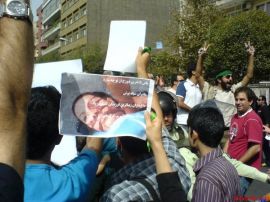 Demonstration on September 18, 2009. Photo by .faramarz on flickr.Obama has several aims in mind. He is trying to pressure the weakened Islamic Republic that is under the fire of a revolution, to “sober up” and accept the honoured position of being a “Western ally”. This could be a big stone for Obama, with which he could kill two birds, i.e. strengthen the new “western-allied” Islamic Republic and help them suppress the revolution at the same time; and also be able to count on a new ally in the region to help sort out the terrible mess that US imperialism has got itself into in Afghanistan and the Middle East.
Demonstration on September 18, 2009. Photo by .faramarz on flickr.Obama has several aims in mind. He is trying to pressure the weakened Islamic Republic that is under the fire of a revolution, to “sober up” and accept the honoured position of being a “Western ally”. This could be a big stone for Obama, with which he could kill two birds, i.e. strengthen the new “western-allied” Islamic Republic and help them suppress the revolution at the same time; and also be able to count on a new ally in the region to help sort out the terrible mess that US imperialism has got itself into in Afghanistan and the Middle East.
The Ahmadinejad government would love to jump at such a prospect. Ahmadinejad has already been talking about how he should be considered as a “friend” by Obama. In a move that is unprecedented in the last 30 years, Saeed Jalili, Iranian nuclear negotiator, met with William Burns, US envoy and “highest ranking Foreign Service Officer in the United States” as part of the Geneva negotiations.
But there are two problems that will ruin this joint daydreaming and “fishing” on the part of Ahmadinejad and Obama:
- The Islamic Republic has long tied the question of its legitimacy to “opposition to the Great Satan” and leading the camp of Fundamentalist Islamists against the “world of arrogance”. Making a sudden turn and shaking hands with the “Great Satan” will surely further destabilize the regime in its ideological roots and will cause further divisions within it.
- The revolutionary movement that has shaken society for the past three months cannot be stopped by these deals of the ruling class. The masses have entered the pages of history and they will not be driven back so easily.
The Islamic Republic is tangled in a political, economic and diplomatic dead-end and Obama cannot really do much about this fact, as much as he would like to.
Where to go?
We have repeatedly said that the weakness of the Iranian Revolution so far has been the lack of an active and conscious participation by the workers as a class. Although from the beginning we did witness workers’ protests and even strikes, a general strike that could stop the wheels of society never materialised (despite a lot of calls for it from different parts of society).
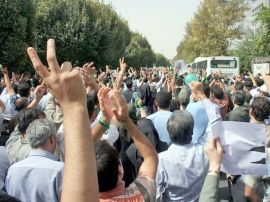 Demonstration on September 18, 2009. Photo by .faramarz on flickr.However, in the last month we have seen an intensification of workers’ struggles which will surely be an important factor in the coming revolution. It is not for nothing that Samare Hashemi, Ahmadinejad’s close advisor, last week had to say in Kerman, “Some of the heads of the opposition after the recent chaos have been trying to create economic sabotage in different sectors such as industry, agriculture and finance. This could lead to sabotage within the regime” [My translation, BK]. We know very well what Mr. Samare is referring to when he speaks of “economic sabotage”. He is referring to strikes that are growing everywhere in Iran.
Demonstration on September 18, 2009. Photo by .faramarz on flickr.However, in the last month we have seen an intensification of workers’ struggles which will surely be an important factor in the coming revolution. It is not for nothing that Samare Hashemi, Ahmadinejad’s close advisor, last week had to say in Kerman, “Some of the heads of the opposition after the recent chaos have been trying to create economic sabotage in different sectors such as industry, agriculture and finance. This could lead to sabotage within the regime” [My translation, BK]. We know very well what Mr. Samare is referring to when he speaks of “economic sabotage”. He is referring to strikes that are growing everywhere in Iran.
On October 3, the Haft Tapeh agribusiness workers started new protests, gathering in front of the doors of the management offices. They are demanding the unpaid wages of the last two months. On September 26, autoworkers at the Zagros Factory in Boroujerd organized a gathering for the third day in a row protesting non-payment of their wages. Before this we also saw the three-day strike of some of the workers in the textile factory of Kerep-Naaz in Kermanshah province. The employers had to give in to some of the workers’ demands and the workers have threatened that they will go on strike again if all their demands are not met. Now everybody is talking about how the “Blue-collars” have also risen.
Iran is passing through a decisive moment. The people’s movement is growing and seeking every opportunity to assert its power. Every official occasion is exploited to express the anger of the people. Demonstrations for the anniversary of the 1979 Revolution next February will undoubtedly turn out once again to be anti-government demonstrations. Workers and the people should use every opportunity to raise revolutionary morale and the true heritage of the defeated 1979 revolution and go toward to finish what the 1979 revolution left unfinished: to bring down Iranian capitalism and establish workers’ rule.
What is required is for the working class to step forward in a decisive manner and put itself at the head of the protest movement. The youth in particular should turn to the workers directly and unite the student movement with that of the working class. The demands of the workers on such questions as jobs for all, decent wages and conditions, should be brought together with those of the movement as a whole. All this should be part of the preparation of a mass, all-out general strike at some stage. That is what will finally put the nails in the coffin of this hated regime.
If a genuine revolutionary party of the working class existed, the whole process could be accelerated. All the conditions have matured for a revolutionary overthrow of the regime. Lacking this revolutionary leadership of the working class, we see the present situation, where the movement rises and recedes again, at each step drawing lessons and preparing for the next stage. This creates a vacuum, which unfortunately can even be filled by elements such as Mousavi, who instead of leading is using his authority to hold the movement back.
All genuine Communists, Socialists and Marxists in Iran should be working towards building what is missing, a revolutionary party of the working class. However, the masses will not sit and wait for such a party to be built. They will move through whichever channels are available. To the degree that the working class, in unity with other oppressed layers in society, such as women and youth, plays the role that history has reserved for it in the upcoming developments, the Iranian Revolution will take an important step forward.

